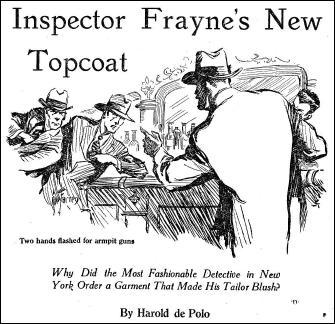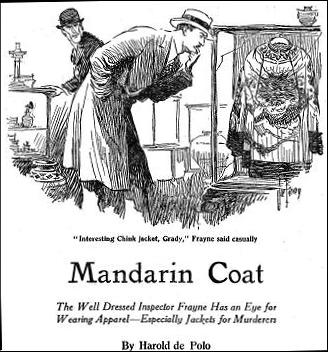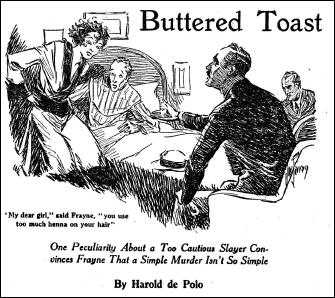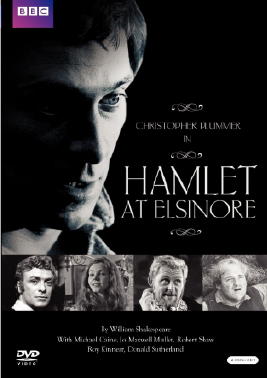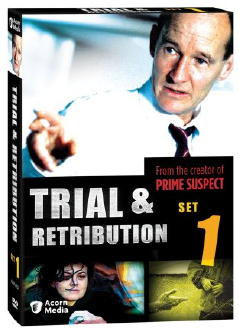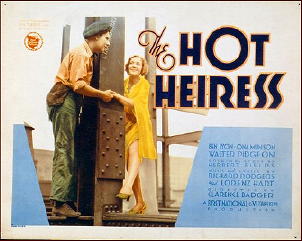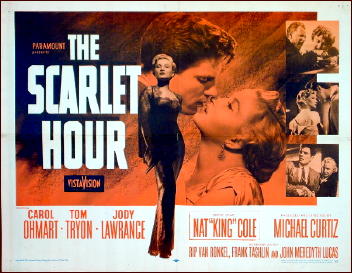February 2012
Monthly Archive
Sun 19 Feb 2012
THE BACKWARD REVIEWER
William F. Deeck
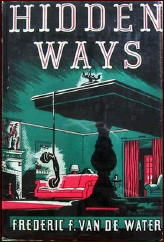
FREDERIC F. VAN DE WATER – Hidden Ways. Bobbs Merrill, hardcover, 1935. Dell #67, mapback edition, no date stated [1944].
A rich spinster of uncertain age, Miss Agatha Paget has hired Everett Ferriter, genealogist, to work on an. unexpurgated history of her family. When an apartment in the building in which she lives becomes vacant, she recommends that Ferriter move in.
One afternoon a man who has been stabbed to death is found in Ferriter’s apartment, a man who had not been seen entering the building. If it was not someone on the premises, the murderer had also not been seen entering the building or leaving it.
In addition to the police investigation, David Mallory, hall man at the apartment house and former reporter looking for a job on a newspaper, takes it upon himself, and does a poor job, to solve the murder. He has fallen in love at first sight with Miss Agatha’s niece, and anyone who can fall in love at first sight is non compos for the duration, as far as I’m concerned.
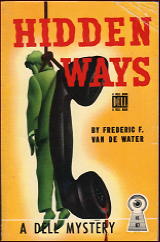
While Miss Agatha knows whodunit immediately, she has no particular interest in seeing the murderer unmasked. Or she doesn’t until the police begin suspecting her feckless nephew.
What raises this book beyond the average mystery novel is the presence of Miss Agatha. She had had “infantile paralysis” — for young readers, this is what poliomyelitis, if indeed that is a word still recognized, used to be called — at age twelve and has been confined to a wheelchair since then.
Fortunately, her intelligence and her sense of humor have not been affected by the paralysis of her legs. For example, her views on opera, pace Marv Lachman: “I grew tired long ago of hearing nonsense sung in one language by folks who speak another, to people who don’t understand either.”
— From The MYSTERY FANcier, Vol. 11, No. 1, Winter 1989.
Editorial Comments: The reference to long-time mystery fan Marv Lachman refers to the latter’s equally long love of the opera. The two fields of interests have overlapped several times, resulting in a number of articles about (and checklists of) fictional murders with operatic settings.
Frederic F. Van de Water (1890-1968) has eight entries in the Revised Crime Fiction IV, by Allen J. Hubin, including one story collection. He had one series character, John Tarleton, who appeared in two of them, neither of which was Hidden Ways.
Sat 18 Feb 2012
THE SERIES CHARACTERS FROM
DETECTIVE FICTION WEEKLY
by Monte Herridge
#11. INSPECTOR FRAYNE, by Harold de Polo.
Harold de Polo created a short-lived series about a dandy police inspector named Frayne. Frayne prides himself on being the best-dressed man in the police department and one of the best in the city.
His personal assistant is a red-haired detective named Don Haggerty, who was known in the department as Frayne’s right-hand man. He did many of the basic detective chores required in investigations, such as looking over the crime scene for any interesting signs or clues. He was also known as “a bulldog on the trail, too.†(The Small Glass Eye, DFW, 14 Sept 1929)
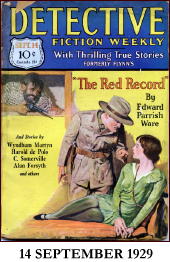
Haggerty was indispensable to Inspector Frayne in his cases. Frayne considered him a man-hunter in training, and his personal protégé. However, Frayne noted that Haggerty was “still young enough to have likes and dislikes. Inspector Frayne called them intolerances, stumbling blocks in the path of efficient police duty.†(The Small Glass Eye)
This view of Frayne gives a clue to his personality, showing that he believed that efficiency and unemotional attitudes were the key to better detective work. In the previously mentioned case he had an innocent person arrested for a murder so that the real murderer would believe he was free of suspicion.
Frayne often used psychological tricks to get suspects and witnesses to respond in the way he wished. Haggerty knew that the “manhunter never assumed an attitude, never made a gesture, never uttered a word, that didn’t mean something.†(La Linda Paloma) In this story Frayne “was simply getting his suspects more on edge.â€
One problem with some of the stories is that Frayne seems to operate as an intuitive detective, with not much in the way of clues to show his line of thinking. “La Linda Paloma†actually is much better than the usual stories in the series; he has definite clues and details how they affected his thinking.
In the earliest of the stories in the series, “The Small Glass Eye,†Frayne investigates a crime out of his jurisdiction at a lake in the Adirondacks. The cause of his investigating this murder illustrates a facet of Frayne’s personality. His one interest, aside from his clothes, was in investigating murders. It was a hobby with him, and “He could sniff it a mile off, a thousand miles off, … †After reading a couple of newspaper articles about the death of millionaire Gideon Whipple, Frayne was certain that it was not an accidental death but a purposeful murder.
One of Frayne’s regular habits was his reading of all the morning newspapers in New York, as well as many papers from other cities including some foreign ones. He was noted as a speed reader, which was an advantage considering how many newspapers he read. He also had “a reading knowledge of seven or eight languages.†(La Linda Paloma) His greatest trait was that he had a photographic memory for all of the newspaper pieces he read, and could recite lines and paragraphs going back years.
Frayne had seven telephones, some of them private and others for business. Six of his telephones were in his apartment in the East Fifties of New York City, and the seventh in his basement shooting gallery. One of his private lines was directly connected to Don Haggerty’s office at police headquarters. When he wanted to summon Haggerty, Frayne picked up the telephone and clicked his message by moving the receiver up and down. Haggerty responded similarly.
Frayne lived close to police headquarters, because as noted in the stories it took Haggerty only twelve minutes to make the trip to Frayne’s residence. Frayne’s multistory home is well suited for him. Special closets for his clothes, for example. The basement has a special shooting range so that Frayne can keep in practice with his specially made and altered blunt-nose automatic. He has one his topcoats specially altered so he can draw his gun faster.
Frayne also had several automobiles, all well powered. One is a roadster. Frayne does not have to worry about his expenses based upon his detective’s pay; he can afford to own all of these things because he “possessed a sufficiently substantial private fortune to enable him to do this,†(The Missing Clew).
Haggerty’s responsibilities change somewhat over the course of the series. He gradually was given more responsibility, and became the “buffer†for Frayne. In this position, Haggerty had to weed out the homicide cases for which Frayne was suited, and “to offer his chief only such problems as appeared to be impossible to unravel.†(Pelican Plot)
In other words, common murder cases of no difficulty were refused by Haggerty. Haggerty at this point spoke to Frayne over a special wire connection to Frayne’s apartment, using a number known only to him.
Other than Haggerty, there are only a couple of other recurring characters in the series. One is Grady, the coroner, who is also an expert on guns and a friend of Frayne’s. He “was one coroner who didn’t hanker to be a great detective.†(Mandarin Coat)
There is a detective named Mullins, who “was a slim stoop-shouldered man in a pepper-and-salt suit far from new. His eyes looked tired…†(Buttered Toast) Mullins has dreams of solving murders. He also is able to identify criminals based on witness descriptions. He knows a considerable amount about the local criminals and their habits and hangouts. Frayne relies on him to help in some of his cases.
In the story “Inspector Frayne’s New Topcoat†Frayne is after the gangsters who killed a homicide detective and “one of Frayne’s favored men.†In this story, too, Frayne has an innocent man arrested as a way to get at the guilty party. Seems to be one of his methods of operation.
“The Missing Clew†involves Frayne’s investigation of the murder of an eccentric rich man. Once more he intuits what really occurred, from the evidence of muddy dog footprints. A minor story in the series.
“Buttered Toast†is a much better story, as Frayne unravels the mystery of what seems to be a simple robbery and murder of a jewelry wholesaler. Frayne comes across many clues and uses them to deduce an unusual crime and the motives for it. In this story, Haggerty is noted as being an improving fingerprint expert.
“Mandarin Coat†is an interesting story of an investigation by Frayne of a poisoning case. The puzzle is how was the poison administered to the victim, and who could have done it. The method of poisoning is a clever one. The story could have been a bit longer, to explain how Frayne learned some of the facts he disclosed late in the story.
In “Pelican Plot†Frayne has to unravel the who and how of a murder case seemingly impossible. Mr. Kerfoot, a rich manufacturer, has a bronze figure of a pelican on his desk that is wired to follow certain instructions such as raising windows, opening a door, and pulling out chairs for guests. However, it turns out that someone has added an extra command for seemingly shooting a gun from a hidden place. Another case where Frayne seemingly intuits the solution with ease.
In “La Linda Palomaâ€, the next story in the series, Frayne has to find the murderer of a personal maid to a world famous dancer named La Linda Paloma. Any of a number of people nearby could have stabbed the woman, so Frayne has to find small clues that point the way.
The series as a whole is just an average detective series, with nothing particularly special about it. Harold de Polo had more success with his stories featuring hick country law enforcement officials. There were two series of these: Sheriff Ollie Bascomb, and another featuring Sheriff Whitcher Bemis. Both had elements of humor in them. Another outdoor series featuring Chan Buzzell was a bit more serious.
The Inspector Frayne series, by Harold de Polo:
In Detective Fiction Weekly:
The Small Glass Eye September 14, 1929
Inspector Frayne’s New Topcoat November 2, 1929
The Missing Clew December 21, 1929
Buttered Toast January 25, 1930
Murder in the Tower March 1, 1930
Mandarin Coat March 8, 1930
Pelican Plot April 5, 1930
The Flying Corpse July 12, 1930
The Little White Powder July 26, 1930
La Linda Paloma December 27, 1930
Peter Wenda, Beads January 24, 1931
In Complete Detective Novel Magazine:
Night Club Riddle May, 1931
In The Underworld Magazine:
Inspector Frayne Returns July, 1933
Previously in this series:
1. SHAMUS MAGUIRE, by Stanley Day.
2. HAPPY McGONIGLE, by Paul Allenby.
3. ARTY BEELE, by Ruth & Alexander Wilson.
4. COLIN HAIG, by H. Bedford-Jones.
5. SECRET AGENT GEORGE DEVRITE, by Tom Curry.
6. BATTLE McKIM, by Edward Parrish Ware.
7. TUG NORTON by Edward Parrish Ware.
8. CANDID JONES by Richard Sale.
9. THE PATENT LEATHER KID, by Erle Stanley Gardner.
10. OSCAR VAN DUYVEN & PIERRE LEMASSE, by Robert Brennan.
Sat 18 Feb 2012
Posted by Steve under
ReviewsNo Comments
IT IS PURELY MY OPINION
Reviews by L. J. Roberts
KELLI STANLEY – The Curse-Maker. St. Martin’s Press/Minotaur Books, hardcover, February 2011.
Genre: Historical Mystery. Leading character: Arcturus; 2nd in series. Setting: Aquae Sulis (Bath), England; Roman Occupation/Ancient Times.

First Sentence: The man was floating, serene, tunic swirling in the undulating waves like clouds against a blue sky.
Arcturus, a Roman physician, and his beautiful wife, Gwyna, have come to Acquae Sulis (Bath) for a holiday and to repair the breach in their marriage. Before they even arrive at their residence, they come across a dead body of a curse-maker floating in the sacred bath.
Instead of a holiday, Arcturus is drawn into the world of curse-makers, deception, attempted seductions, attempts on his and his wife’s lives, and many more murders.
Kudos to Ms. Stanley for the author’s notes, a cast of characters — albeit frustratingly incomplete — and a glossary. They were tremendously helpful.
Ms. Stanley has written a book set in Ancient Times that makes us realize how little some things have changed. Even with the different customs and religion the plot, and certainly the motives, was quite contemporary, and I had to keep reminding myself of the period in which the story was set.
Even the reference to Stonehenge already being ancient during this time, didn’t help cement the feeling of the period. While with some books set in an earlier period are able to capture the feel of that time through the syntax of speech, that isn’t possible with classical Latin, but it did leave me with a feeling of the story being somewhat anachronistic.
On the other hand, there was so much to like about this book.
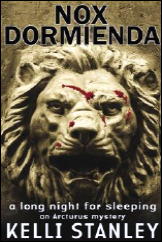
Arcturus is a wonderful character. His style is brusque with a wry humor; he’s both intelligent and tough, he is kind and loves his wife. Gwyna may be beautiful but is certainly not vapid or weak.
Their marriage may be going through a rough patch, but it will be resolved. The relationship is a critical element of the story and is used to enhance to story. The household domestic scenes provide both insight to the characters and a respite from the action but did, at times, threaten to divert the mystery.
I particularly liked Ms. Stanley’s ability to create a sense of place. Her descriptions of both places and actions are rich and vivid: “I threw the thought against a wall. It made a small red splat of fear and slowly oozed down to the floor.†Now, how much more powerful is that than saying “It’s like throwing spaghetti against the wall.†I shall certainly always remember her phrase instead.
I have never particularly cared for books set in Ancient Times due, I believe, to the difficulty of creating a realistic sense of time. What Ms. Stanley did achieve was writing a story I very much enjoyed, mainly due to the characters. I was pleasantly surprised just how much I did like the book and would definitely read another book in the series.
Rating: Good Plus.
Editorial Comment: The first book in Kelli Stanley’s “Roman Noir” series was Nox Dormienda (A Long Night for Sleeping) (Five Star, July 2008). It was the winner of that year’s Bruce Alexander Award for best historical mystery, but it went out of print almost immediately.
Fri 17 Feb 2012
REVIEWED BY DAN STUMPF:
HAMLET AT ELSINORE. TV movie, BBC, 15 November 1964. Christopher Plummer, Robert Shaw, Alec Clunes, Michael Caine, June Tobin, Jo Maxwell Muller, Dyson Lovell. Based on the play by William Shakespeare. Director: Philip Saville.
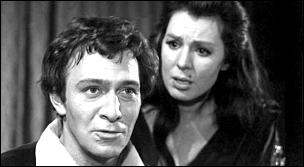
My annual Hamlet-fest last month had its moments, including the 1964 Hamlet at Elsinore with Christopher Plummer backed up by Robert Shaw as a shrewd, virile Claudius, Michael Caine [a year before The Ipcress File] a sardonic Horatio, and Donald Sutherland essaying a Norwegian accent as Fortinbras!
Quite well done, with some understandable echoes of John Barrymore in Plummer’s performance: he dresses like Barrymore, adopts some Barrymore elocutions, and there are moments in his mad scenes that recall Oscar Jaffe in The 20th Century.
There’s also a wonderful twist on the Nunnery Scene: Ophelia is not aware her dad and Claudius are spying on her and Hamlet till the scene ends. And when Polonius tells her they heard everything, Robert Shaw flashes her a smile so nasty he should have won a prize for it.
I also read Henry Treece’s 1966 The Green Man, a retelling of the Danish legends that formed the basis of Hamlet. It recasts the part as Conan the Barbarian, and has its virtues, including vividly-evoked time and place, but overall I was disappointed.
And you?
Fri 17 Feb 2012
REVIEWED BY GEOFF BRADLEY:
TRIAL & RETRIBUTION IV. ITV, UK. October 4 & 5, 2000. 2 x 2 hours, less adverts. David Hayman, Kate Buffery, James McCready, Steven Hartley, Richard McCabe, Dorian Lough, Zoe Lucker. Teleplay: Lynda La Plante. Director: Michael Whyte.
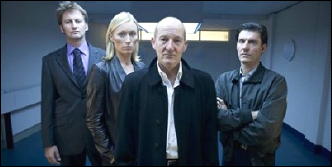
This fourth series brings back Detective Superintendent Mike Walker (hardly a likeable cop) and Detective Inspector Kate North, still living together after meeting on the original T&R.
North is included in a team that is investigating an eight year-old murder where the convicted killer, James McCready, is alleging miscarriage of justice with the help of a barrister MP and a television reporter. It all hinges on police skulduggery in the original team led by, yes you’ve guessed it, Walker. North states her relationship but, rather improbably (to state the obvious) is told to carry on anyway.
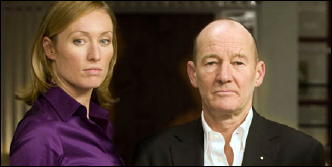
Quite watchable but it’s cliched (very). For example Walker, suspended but continuing to investigate, finds evidence in Glasgow that McCready has committed a murder there 12 years earlier. Next day, the day the appeal opens, he is travelling back to London so he phones North, at home and pregnant, and tells her to rush to the court of appeal to say that this vital evidence is on the way.
Why could he not ring direct, why could he not ring his police station, why indeed didn’t he ring the night before when he found the evidence? And anyway it doesn’t take a legal genius to work out that the evidence of an earlier crime would have absolutely NO effect on the appeal against conviction in a later one.
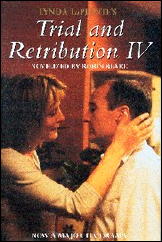
Still it creates the excuse for the pregnant North to rush, trip on the mat and collapse. Two more dramatic situations are set up — will the evidence get there in time and will the baby survive?
There were lots more situations like this to groan over, but if you want to pass an undemanding (just under) four hours this should do it. It’s just a shame that after the superb original Trial And Retribution (1997), it’s been steadily downhill.
Lynda La Plante (writer, producer, etc.) has become a churner out of trifles. Incidentally the novelisation of this story has been produced with La Plante’s name prominently on cover, spins, title page and copyright page. The cover also though reveals “Novelized by Robin Blake.” Note, too, it’s “Novelized”, not “Novelised.” What are things coming to?
— Reprinted from Caddish Thoughts #87, November 2000.
Editorial Comments: There have now been 10 seasons of Trial & Retribution, the most recent having been aired in 2008. There are no plans to continue. Seasons one through four are available in the US as one DVD box. (See below.) I believe all of the others have also been released in this country.
Thu 16 Feb 2012
REVIEWED BY WALTER ALBERT:
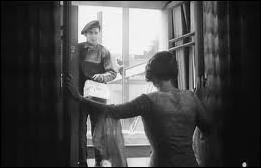
THE HOT HEIRESS. First National, 1931. Ben Lyon, Ona Munson, Walter Pidgeon, Tom Dugan, Holmes Herbert, Inez Courtney, Thelma Todd. Music and lyrics by Richard Rodgers and Lorenz Hart; cinematographer: Sol Polito. Director: Clarence G. Badger. Shown at Cinecon 39, Hollywood CA, Aug-Sept 2003.
An excerpt from this musical was included in a laser disk box set of early sound films. Lyon, as riveter “Hap Harrigan”, works and sings until a hot rivet flies through the window of sleeping socialist Ona Munson (“Juliette Hunter”), who, after an initial uncomfortable moment, likes what she sees through the window and invites Hal the Riveter to come in through the window for lunch.
It was good to see the rest of the film, which traces the difficult courtship of Lyon and Munson, an apparently ill-fated romantic pair, although the difference is in class and not in warring families and the movie does have a happy ending.
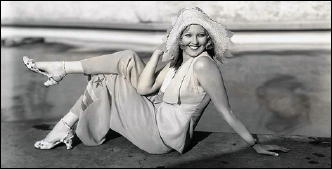
Walter Pidgeon is Munson’s proper suitor, Thelma Todd, a most attractively photographed (she doesn’t do much acting) society friend of Munson’s, and Tom Dugan and Inez Courtney friends of Hal’s who double date with the ill-matched couple: The most extended sequence is a weekend party at the estate of Juliette’s wealthy parents where Juliette’s family and friends do their damdest to break up the couple.
Only three of the Rodgers-Harts songs were used, but the sprightly direction and accomplished performances made this an entertaining attraction.
Editorial Comment: The photo just above is that of Thelma Todd, reportedly taken in connection with (or from) The Hot Heiress. For a glimpse of Ona Munson and Ben Lyon singing “You’re The Cats, You’re The Berries” from this film, check out this YouTube clip online here.
Wed 15 Feb 2012
Posted by Steve under
Reviews[2] Comments
THE ARMCHAIR REVIEWER
Allen J. Hubin
JAN ADKINS – Cookie. Harper & Row, hardcover, 1988. No paperback edition.
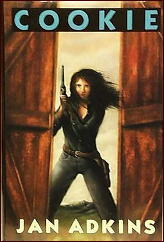
Jan Adkins’ Cookie is set in Washington, where Cookie Culler, a 40ish compulsive sort, runs the ranch she inherited from her father. She’s well-liked in the local town, where she’s bedded most of the eligible males, and this comes in handy when brother Benjy comes home.
It seems his troubled life has taken a turn for the worse. While flying a load of dope across the Mexican border for a syndicate of Eastern dentists, he crashed the plane and destroyed the dentists’ investment. They are not happy, and want at least a piece of Benjy’s hide.
Cookie will help her brother, of course, but he’s not telling everything and the affair turns explosively deadly, with the ranch under siege. This is an utterly compelling narrative which defies being put down; even the detailed eroticism is integral to the story.
— Reprinted from The MYSTERY FANcier,
Vol. 11, No. 1, Winter 1989.
Bio-Bibliographic Data: Contrary to expectations, perhaps, Jan Adkins is male, and possibly even more surprising (given the last line of Al’s review) is that most of his fiction was written for Young Adults. His only only venture into Crime Fiction was Deadline for Final Art (Walker, 1990), a spy novel featuring Russians and a Star Wars project.
For more information on the author, including his many works of non-fiction and an impressive list of various awards he’s received, check out his website here.
Wed 15 Feb 2012
IT’S ABOUT CRIME, by Marvin Lachman
— Reprinted from
The MYSTERY FANcier,
Vol. 11, No. 1, Winter 1989.
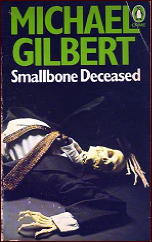
Finally, Michael Gilbert is getting the recognition he deserves. In 1987 he received a Grand Master Award from MWA, in 1988 publishers seem to be falling all over themselves to reprint him, and that is good news for American mystery readers.
Incidentally, Gilbert, who only recently retired as an attorney, did virtually all his writing while commuting by train to London. Yet he had a very active practice and even was Raymond Chandler’s solicitor, writing his will. I am in awe of Gilbert since my own railroad-commuting days were much less productive, limited to reading the newspaper in the morning and napping, despite my best efforts to stay awake, in the evening.
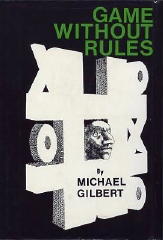
Penguin has reprinted Smallbone Deceased for $3.95, and there is no better possible introduction to Gilbert than this very early (1950) work. It contains many of the elements of the classic puzzle: the bizarre crime (a body is found in a large deed box at a law office), a diagram of the office, and clever chapter headings which fit in with the legal background of this mystery.
Gilbert’s sophisticated writing and expert character development make this book very “modern” for its time, since it was written when most puzzle writers used large chunks of cardboard with which they created the people in their books.
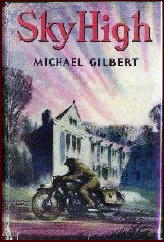
Gilbert is one of the finest short-story writers around, and Carroll and Graf has reprinted his wonderful collection of Calder and Behrens spy stories, Game Without Rules (1967), $3.95. This edition contains the original British titles, though many stories appeared in EQMM under different titles.
By whatever name, most of the stories In this collection are a perfect antidote for readers who are tired of the cynicism and lack of action in John Le Carre. Gilbert’s adept plotting and wit make each story a joy to read and convince me the short story is the proper length for espionage fiction. Especially recommended are “The Cat Cracker,” “Trembling’s Tours,” and “Hellige Nacht,” three of the very best spy short stories ever.
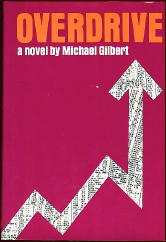
Carroll and Graf has also reprinted, for $3.95, Overdrive (1967), a novel which received considerable critical acclaim, though I found the protagonist, Oliver Nugent, too ruthless to permit me to identify with him.
Allen J. Hubin’s highly favorable review of this book in a Minneapolis newspaper was brought to the attention of the editor of the New York Times Book Review and led to, from 1968 to 1971, his being the first (and far and away the best) replacement for Anthony Boucher.
From Perennial Library comes The Country-House Burglar (1955), $4.95, and The Crack in the Teacup (1966), $3.95, two village mysteries which stress the charm of the British countryside but crackle with surprise and clever plotting. A bonus is the subtle way Gilbert works choral singing and cricket, respectively, into the stories.
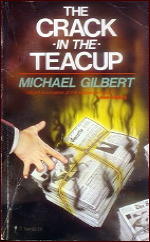
â— Smallbone Deceased. Hodder & Stoughton, UK. hardcover. 1950. Harper & Brothers, US, hardcover, 1950.
â— Game Without Rules. Hodder & Stoughton, UK, hardcover, 1968. Harper & Row, US, hardcover, 1967.
â— Overdrive. Harper & Row, US, hardcover, 1968. First published in the UK by Hodder & Stoughton as The Dust and the Heat, hardcover, 1967.
â— The Country-House Burglar. Harper & Brothers, US, hardcover, 1955. First published in the UK by Hodder & Stoughton as Sky High, hardcover, 1955.
â— The Crack in the Teacup. Hodder & Stoughton, UK, hardcover, 1966. Harper & Row, US, hardcover, 1966.
Tue 14 Feb 2012
THE BACKWARD REVIEWER
William F. Deeck
ROSEMARY KUTAK – I Am the Cat. Farrar Straus & Co., hardcover, 1948. Unicorn Mystery Book Club. hardcover, 4-in-1 edition, May 1948. Mercury Mysteries #130, digest-sized paperback, no date [1949]. Collier Books, paperback, 1964, 1966, with an introduction by Anthony Boucher.
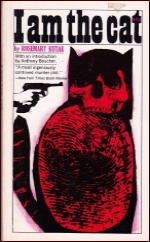
The Collier Books reprint is one in its series of Mystery Classics presumably chosen by Anthony Boucher. Momentarily stifling my bias against know-it-all psychiatrists, I concur with Boucher’s selection.
Taking a break from treating veterans with war-induced traumas, psychiatrist Marc Castleman is spending his leave with his “Aunt” Emily and her houseguests, a fairly motley crew. One of the male guests apparently gets into Castleman’s medical bag and takes an overdose of morphia. When that falls to kill him, he brushes his teeth with a tooth powder made mostly of cyanide, which does the trick.
Was he really trying to kill himself? His sister, as neurotic as he seems to have been, has doubts. The day of the inquest she is found at the foot of the stairs, with a broken neck.
Was her death an accident, or is someone, involved with those two and other houseguests in a tontine, trying to increase his or her income? Will it get down to two, or maybe to one, if the murderer is cunning enough?
Keen readers will spot the murderer the moment Castleman does, although all it is not what it seems.
— From The MYSTERY FANcier, Vol. 11, No. 1, Winter 1989.
BIO-BIBLIOGRAPHICAL DATA: Dr. Marc Castleman appeared in one earlier mystery novel, Darkness of Slumber (Lippincott, 1944). For more on that book plus some biographical data about the author, whose only two crime novels these are, check out this earlier post on the blog.
Mon 13 Feb 2012
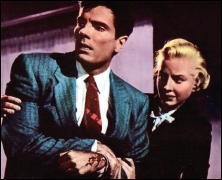
THE SCARLET HOUR. Paramount Pictures, 1956. Carol Ohmart, Tom Tryon, Jody Lawrance, James Gregory, Elaine Stritch, E.G. Marshall, Edward Binns, Scott Marlowe, Billy Gray, David Lewis, Nat “King†Cole. Director: Michael Curtiz.
Sometimes you have to sift through a lot of Fool’s Gold as you make your way through a stack of would-be Film Noir movies on DVD before you find a true nugget, the Real Thing, and this movie is it.
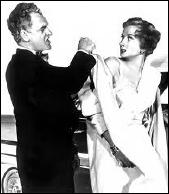
Apparently it’s all but unknown. Right now there’s been only one person who’s left a comment about it on IMDB (and his opinion is the same as mine – “a small gemâ€), and no links to external reviews (until this one shows up there).
The basic plot line sounds like The Postman Always Rings Twice, but (a) there are a lot of variations possible on that particular theme, and this film has them, and (b) as much as I’d like to say otherwise, it’s almost but not quite in that league.
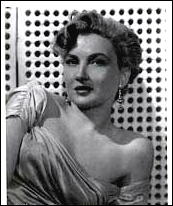
Carol Ohmart, for example, as the femme fatale, whom Tom Tryon’s character has fallen in love with, has nowhere near the screen presence of Lana Turner, even on the latter’s worse days and Miss Ohmart’s best.
In The Scarlet Hour the latter’s role is a little too tough and hardbitten if you were to compare her to Miss Turner in Postman, but to her credit, she does manage to get the impossibly handsome Mr. Tryon to fall in love with her.
Even if she already has a husband. Tom Tryon works for the man (James Gregory), a real estate kind of guy; Tryon’s his top salesman. And neither Ohmart and Tryon have murder on their mind; all they need is the money to run away together.
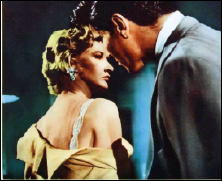
Enter a gang of crooks they overhear casing a house. A third of a million dollars; worth of jewels sounds good to them, and hijacking the burglars’ loot after they’ve cracked the safe sounds easy and all but foolproof.
We know better. Plans like this seldom work out as planned. The husband gets suspicious, for one thing, and suspicious husbands always put rocks in the crankcase.
We (the viewer) easily find ourselves anticipating a couple of the more immediate outcomes, but probably not the third (speaking for myself, that is).
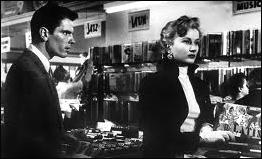
There is a fourth important player in the game, which I almost forgot to tell you about, and that is Mr. Tryon’s secretary (Jody Lawrance), who is – but more I will not tell.
The ending of The Scarlet Hour is also nowhere near as memorable as that of Postman, but it’s nearly as good, and it certainly is as inevitable. Beside my recommendation as spelled out so far, you also get a bonus of Nat “King†Cole singing a song in a nightclub. I’m not sure the plot required a singer in a nightclub, but singers in nightclubs appear in lots of noir films, and this he’s the one in this one. (It was also David Lewis’s film debut, for whatever that particular fact may be worth to you.)
« Previous Page — Next Page »



